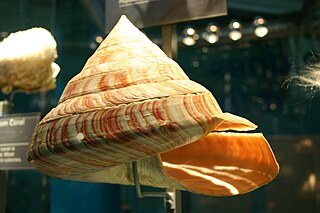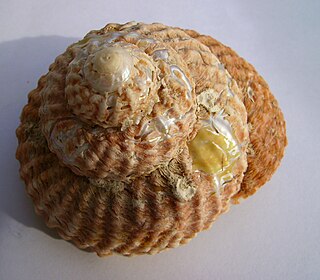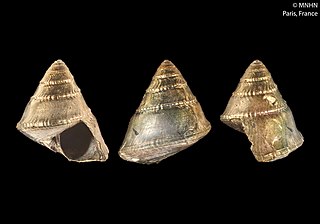
In mammalian oral anatomy, the canine teeth, also called cuspids, dog teeth, or fangs, eye teeth, vampire teeth, or vampire fangs, are the relatively long, pointed teeth. They can appear more flattened however, causing them to resemble incisors and leading them to be called incisiform. They developed and are used primarily for firmly holding food in order to tear it apart, and occasionally as weapons. They are often the largest teeth in a mammal's mouth. Individuals of most species that develop them normally have four, two in the upper jaw and two in the lower, separated within each jaw by incisors; humans and dogs are examples. In most species, canines are the anterior-most teeth in the maxillary bone.
The radula is an anatomical structure used by mollusks for feeding, sometimes compared to a tongue. It is a minutely toothed, chitinous ribbon, which is typically used for scraping or cutting food before the food enters the oesophagus. The radula is unique to the molluscs, and is found in every class of mollusc except the bivalves, which instead use cilia, waving filaments that bring minute organisms to the mouth.
Ferugliotherium is a genus of fossil mammals in the family Ferugliotheriidae from the Campanian and/or Maastrichtian period of Argentina. It contains a single species, Ferugliotherium windhauseni, which was first described in 1986. Although originally interpreted on the basis of a single brachydont (low-crowned) molar as a member of Multituberculata, an extinct group of small, rodent-like mammals, it was recognized as related to the hypsodont (high-crowned) Sudamericidae following the discovery of additional material in the early 1990s. After a jaw of the sudamericid Sudamerica was described in 1999, these animals were no longer considered to be multituberculates and a few fossils that were previously considered to be Ferugliotherium were assigned to unspecified multituberculates instead. Since 2005, a relationship between gondwanatheres and multituberculates has again received support. A closely related animal, Trapalcotherium, was described in 2009 on the basis of a single tooth.

The maxillary lateral incisors are a pair of upper (maxillary) teeth that are located laterally from both maxillary central incisors of the mouth and medially from both maxillary canines. As with all incisors, their function is for shearing or cutting food during mastication, commonly known as chewing. There are generally no cusps on the teeth, but the rare condition known as talon cusps are most prevalent on the maxillary lateral incisors. The surface area of the tooth used in eating is called an incisal ridge or incisal edge. Though relatively the same, there are some minor differences between the deciduous (baby) maxillary lateral incisor and that of the permanent maxillary lateral incisor. The maxillary lateral incisors occlude in opposition to the mandibular lateral incisors.

In human dentistry, the maxillary canine is the tooth located laterally from both maxillary lateral incisors of the mouth but mesial from both maxillary first premolars. Both the maxillary and mandibular canines are called the "cornerstone" of the mouth because they are all located three teeth away from the midline, and separate the premolars from the incisors. The location of the canines reflect their dual function as they complement both the premolars and incisors during mastication, commonly known as chewing. Nonetheless, the most common action of the canines is tearing of food. The canines often erupt in the upper gums several millimeters above the gum line. The canine teeth are able to withstand the tremendous lateral pressure caused by chewing. There is a single cusp on canines, and they resemble the prehensile teeth found in carnivorous animals such as the extinct Saber-toothed cat. Though relatively the same, there are some minor differences between the deciduous (baby) maxillary canine and that of the permanent maxillary canine.

Hydrocenidae is a taxonomic family of minute land snails or cave snails with an operculum, terrestrial gastropod mollusks or micromollusks in the clade Cycloneritimorpha.
Dens evaginatus is a rare odontogenic developmental anomaly that is found in teeth where the outer surface appears to form an extra bump or cusp.

The brown lanternshark or bristled lanternshark is a little-known species of deep-sea dogfish shark in the family Etmopteridae. It is found off Japan and New Zealand, and possibly also South Africa and Australia, typically deeper than 300 m (980 ft). This species can be distinguished from other lanternsharks by its coloration, which is a uniform dark gray or brown without the ventral surface being much darker and clearly delineated from the rest of the body. The brown lanternshark feeds on small bony fishes, cephalopods, and crustaceans. Reproduction is ovoviviparous, with females giving birth to 9–18 young. An unusually high proportion of individuals in Suruga Bay are hermaphrodites, with both male and female characteristics.

Talon cusp is a rare dental anomaly resulting in an extra cusp or cusp-like projection on an anterior tooth, located on the inside surface of the affected tooth.
Dental anatomy is a field of anatomy dedicated to the study of human tooth structures. The development, appearance, and classification of teeth fall within its purview. Tooth formation begins before birth, and the teeth's eventual morphology is dictated during this time. Dental anatomy is also a taxonomical science: it is concerned with the naming of teeth and the structures of which they are made, this information serving a practical purpose in dental treatment.

Carinariidae, known by the common name "heteropods" like their relatives in the Pterotracheoidea, is a taxonomic family of swimming or floating sea snails, pelagic marine gastropod molluscs in the clade Littorinimorpha.

Pleurotomariidae, common name the "slit snails", is a family of large marine gastropods in the superfamily Pleurotomarioidea of the subclass Vetigastropoda. This family is a very ancient lineage; there were numerous species in the geological past. The genus includes several hundred fossil forms, mostly Paleozoic. It is one of the oldest gastropod families, commencing in the Cambrian.

Pseudococculinidae is a family of small sea snails or false limpets, marine gastropod mollusks in the superfamily Lepetelloidea.

Cantharidus, common name the kelp shells, is a genus of sea snails, marine gastropod molluscs of the family Trochidae, the top shells.

Cookia sulcata, or Cook's turban, is a species of large sea snail, a marine gastropod mollusc in the family Turbinidae, the turban snails.
The Cook's swellshark is a little-known species of catshark, belonging to the family Scyliorhinidae. This shark is found in the Arafura Sea at a depth of 223–300 m (732–984 ft). It is a stocky-bodied shark with a short, broad head and a large mouth, and can be identified by the eight dark, pale-edged saddles along its grayish brown body and tail. The maximum known length of this species is 30 cm (12 in). Like other swellsharks, it can inflate itself with water or air when threatened.

Asthelys is a genus of sea snails, marine gastropod mollusks in the family Seguenziidae.
Sericogyra is a genus of sea snails, marine gastropod mollusks in the family Seguenziidae.
Bathymophila callomphala is a species of sea snail, a marine gastropod mollusk in the family Solariellidae.
Heptranchias howelli, the sevengill shark, is a nektonic carnivore in the genus Heptranchias. It is an extinct species that ranged from 37.2 to 20.43 Ma.











